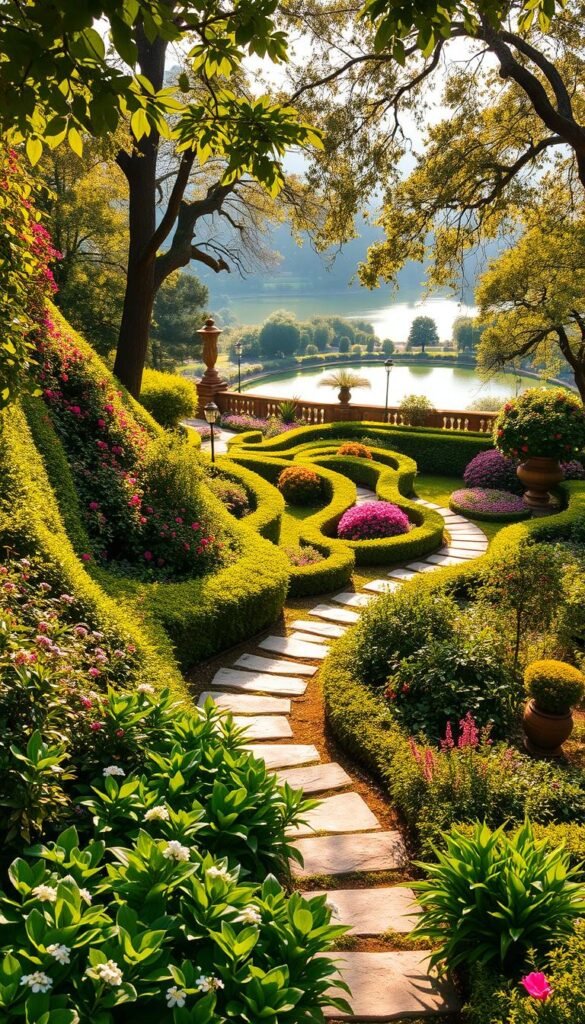Working with a sloped yard might feel overwhelming at first, but it’s packed with hidden potential. Picture transforming that tricky incline into a cascading series of vibrant outdoor spaces. Instead of fighting the natural lay of the land, you can use its contours to craft something truly special.
Steep terrain often brings challenges like soil erosion and uneven drainage. But these issues become opportunities when approached thoughtfully. By building tiered areas, you’ll stabilize the ground while adding visual depth. This method isn’t new—it’s an age-old practice that balances practicality with artistry.
Imagine walking through your yard and discovering distinct “rooms” filled with textures, colors, and scents. Each level can serve a purpose, whether it’s a cozy seating nook or a pollinator-friendly planting zone. The key lies in blending structural elements like retaining walls with plants that thrive on slopes.
Want to elevate your gardening aesthetic? Start by assessing your space’s angle and soil type. Even steep hillsides can become stunning focal points with smart planning. Let’s turn your challenging slope into a dynamic outdoor sanctuary that feels both intentional and effortlessly natural.
Understanding Your Slope and Landscape
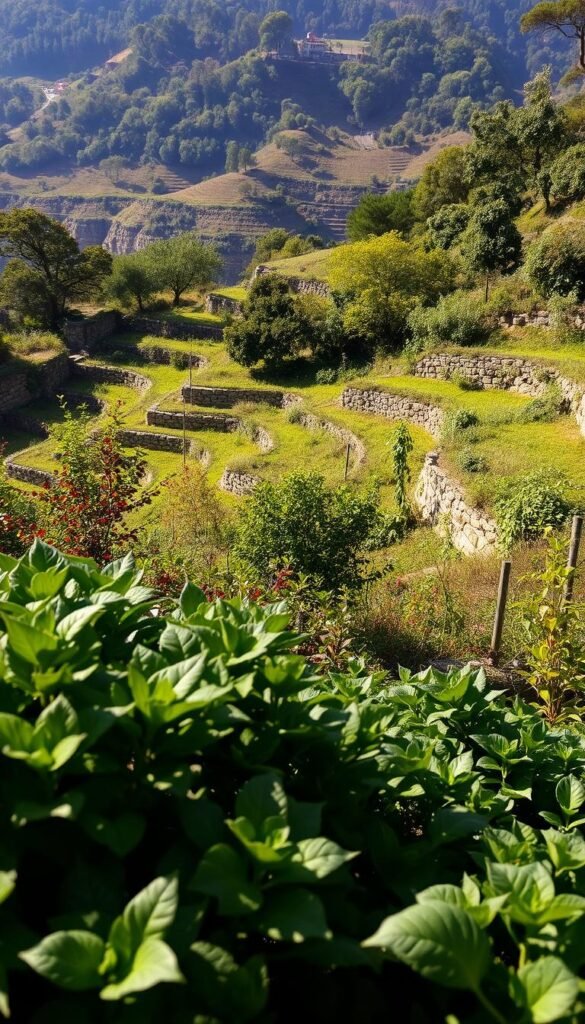
Your sloped landscape holds secrets waiting to be unlocked through careful observation. Three factors shape your strategy: how steep it is, what’s underfoot, and how you’ll move through the space. Let’s decode these elements to build a stable foundation for your vision.
Assessing Grade, Exposure, and Accessibility
Start by measuring your incline’s steepness. Gentle slopes (under 10°) might only need strategic plantings, while steeper angles demand retaining walls. Sun exposure matters too—south-facing areas bake in summer, while north sides stay cooler.
Wind patterns and rainfall intensity affect plant choices. For example, loose soil on windy ridges needs windbreaks. Always map out pathways early. Can you safely reach every level? Stepped stones or switchback trails often work better than straight staircases.
| Soil Type | Drainage Speed | Erosion Risk | Best Use |
|---|---|---|---|
| Sandy | Fast | High | Drought-tolerant plants |
| Clay | Slow | Low | Rain gardens |
| Loamy | Moderate | Medium | Mixed plantings |
Analyzing Soil Type and Drainage Needs
Squeeze a handful of damp earth. If it crumbles quickly, you’ve got sandy soil. If it forms a dense ball, clay dominates. Loamy soil? It’s goldilocks-perfect—holds moisture without waterlogging.
Watch how rainwater flows during storms. Redirecting runoff with French drains or swales prevents erosion. Remember: proper drainage protects your investment. One clogged channel can undermine months of work.
An expert eye helps spot hidden issues like buried rocks or underground springs. Address these during planning to avoid surprises later. Your slope’s unique conditions aren’t obstacles—they’re design opportunities in disguise.
Evaluating Structural Elements and Retaining Walls
Sloped landscapes demand smart structural solutions that blend strength with style. The right combination of walls and walkways turns challenging terrain into an inviting, functional space that lasts for generations.
Choosing Durable Materials for Stability
Natural stone and concrete blocks outperform wood in longevity, especially in wet climates. Engineered timber offers a warmer look but requires more maintenance. Consider these factors:
- Local climate impacts material performance
- Proper drainage prevents water buildup
- Professional installation ensures correct load distribution
Concrete walls can last 50+ years with proper footings, while untreated wood may rot in under a decade. Always consult local building codes – some areas require permits for walls over 3 feet tall.
Planning Safe Access with Pathways and Stairways
Create walkways that feel natural yet secure. For steep areas:
- Install steps with 6-7 inch rises
- Use textured surfaces for better grip
- Add solar lights along edges for night safety
Gentle slopes work well with gravel or pavers that complement small-space gardening solutions. Switchback paths reduce erosion while making ascents easier. Remember: every route should serve both practical and visual purposes.
Exploring Multi-Level Terraces and Garden Beds
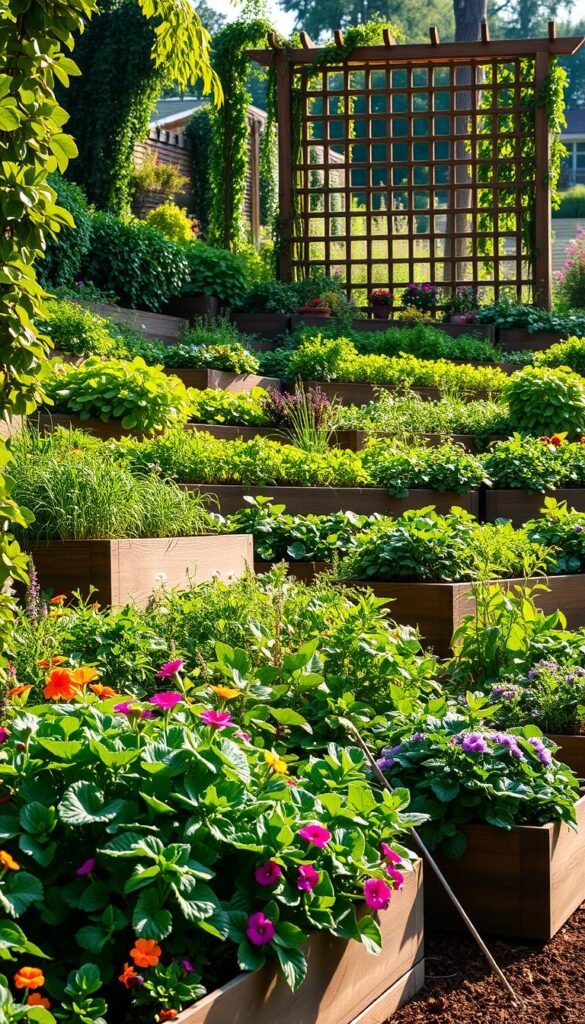
Crafting flat zones on a slope requires both creativity and engineering. By working with your land’s natural contours rather than against them, you’ll create inviting spaces that feel intentional yet organic. This approach lets you maximize every inch of challenging terrain.
Cutting and Filling to Create Level Areas
The cut-and-fill method reshapes your slope into usable platforms. Remove soil from higher areas and redistribute it downhill to form stable planting beds or patio spaces. This technique:
- Prevents erosion through strategic earth movement
- Creates defined areas for dining, growing, or relaxing
- Reduces maintenance by establishing clear boundaries
Always test soil compaction after moving earth. Loose dirt needs time to settle before building permanent features. For quick results, mix in gravel or use geogrid reinforcement.
Integrating Stone, Boulders, and Wood Elements
Natural materials blend function with rugged charm. Local boulders become instant focal points while anchoring loose soil. Try these combinations:
- Flat stones for informal seating walls
- Vertical wood timbers paired with horizontal rock layers
- Boulder “steps” that double as erosion barriers
Railroad ties add warmth between stone retaining walls. Leave gaps for drainage and plant creeping thyme or sedum in crevices. You’ll create texture while softening hard edges.
Remember: Vary bed heights by 12-18″ between levels for visual impact. This staggered approach guides the eye naturally while making plant care easier. Your multi-level layout becomes both practical and picturesque.
Terrace Garden Design: Creating Layers of Beauty on Sloping Land
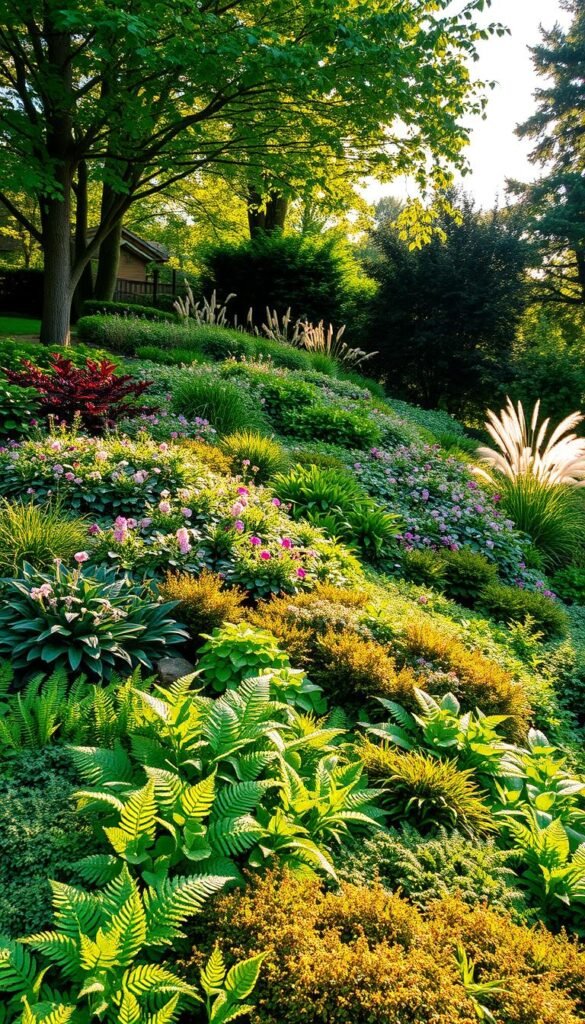
Transforming uneven ground into a living masterpiece starts with smart layering techniques. By combining functional structures with greenery, you craft spaces that invite exploration while keeping soil firmly in place.
Layering Plants, Retaining Walls, and Seating Areas
Start with low-growing groundcovers like creeping phlox to blanket the soil. Add mid-height shrubs such as dwarf hydrangeas for structure. Tall trees like redbuds anchor the scene while preventing erosion.
Retaining walls do more than hold dirt—they become natural benches when built at 18-24″ heights. Use textured stone for visual warmth and slip resistance. These features let you pause and admire your handiwork.
| Plant Type | Function | Top Choices |
|---|---|---|
| Groundcovers | Soil protection | Sedum, thyme |
| Shrubs | Visual structure | Boxwood, spirea |
| Trees | Erosion control | Dogwood, serviceberry |
Maximizing Views with Thoughtful Arrangement
Position seating spots where sightlines frame your best vistas. A fire pit placed uphill becomes a cozy gathering spot with panoramic views. Downhill benches focus attention on eye-catching plant combinations.
Rotate blooming perennials through seasons for constant color. Early tulips give way to daylilies, then asters. This approach keeps your creative outdoor decor looking fresh year-round.
Vary plant textures between levels—feathery grasses beside bold hostas create contrast. Leave space between groups for natural spread. Your landscape becomes a living tapestry that changes with every step.
Incorporating Water Features and Irrigation Systems
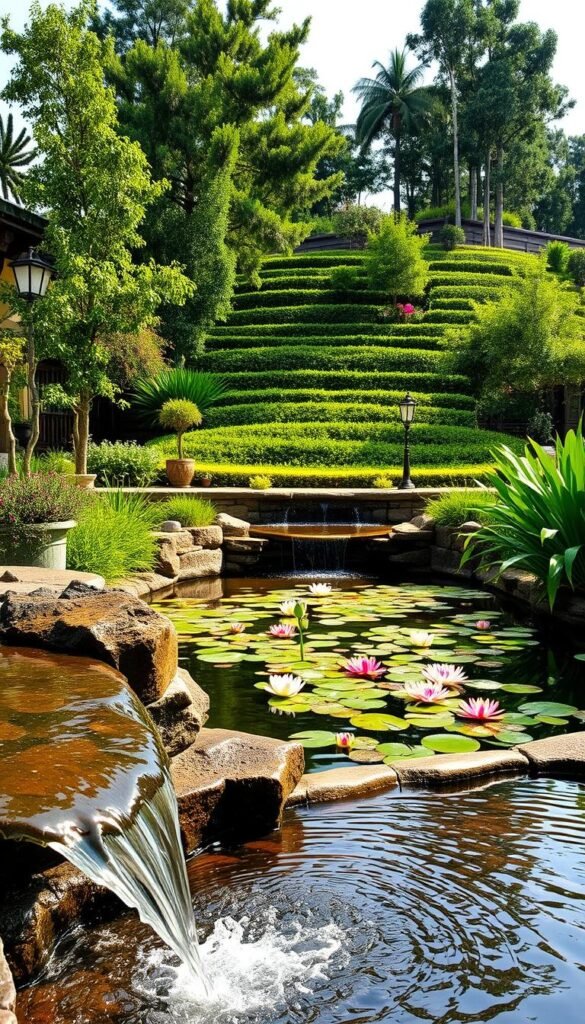
Your slope’s natural drop becomes an asset when water dances down its contours. Strategic placement of aquatic elements solves practical challenges while adding sensory appeal. Let’s explore how flowing water can protect your land and elevate its charm.
Designing Cascading Waterfalls and Streams
Use existing elevation changes to create tumbling waterfalls that stabilize soil. Local stones form natural-looking steps, directing water flow while preventing erosion. A recirculating pump keeps water moving without waste.
Streams winding through planting beds do double duty. They irrigate nearby roots while creating habitats for frogs and dragonflies. Position rocks strategically to control speed—fast sections oxygenate water, while calm pools reflect sunlight.
| Feature Type | Key Benefits | Best Placement |
|---|---|---|
| Stream | Guides runoff | Along pathways |
| Pond | Collects rainwater | Lowest terrace |
| Waterfall | Reduces erosion | Steepest slope |
Ensuring Proper Drainage to Prevent Erosion
Drip irrigation outperforms sprinklers on slopes. Targeted emitters deliver water slowly, letting soil absorb moisture without runoff. Pair this system with French drains hidden under gravel paths.
Swales (shallow ditches) blend into your design while redirecting stormwater. Line them with river rocks and drought-tolerant plants. This approach stops erosion while creating natural-looking water corridors.
Always slope hardscape surfaces 2% away from structures. This simple trick prevents puddling near walls. Your water management system becomes invisible yet highly effective.
Enhancing Your Garden with Native Plants and Mulch
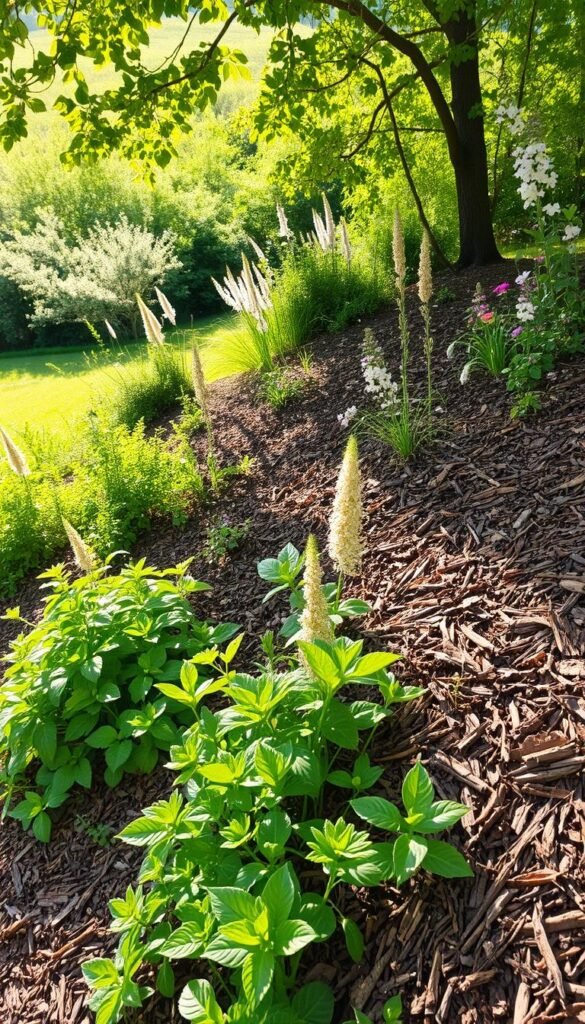
Your hillside becomes a self-sustaining ecosystem when you partner with nature’s original blueprint. Native species thrive where others struggle, offering beauty that deepens with each season while protecting vulnerable soil.
Smart Plant Selection for Lasting Results
Prioritize plants with fibrous root systems that knit the earth together. For sunny spots, try creeping phlox or switchgrass—their roots dig deep to anchor loose dirt. Shady areas benefit from ferns or vinca, which spread quickly to form living carpets.
| Plant Type | Erosion Control | Maintenance Level | Top Picks |
|---|---|---|---|
| Groundcovers | High | Low | Sedges, Thyme |
| Shrubs | Medium-High | Moderate | Spirea, Euonymus |
| Trees | Very High | Low | Dogwood, Vine Maple |
Place drought-tolerant varieties like ornamental grasses at the hill’s crest. Reserve moisture-loving hostas and astilbe for lower areas where water collects naturally. This strategic placement mimics natural watershed patterns.
Mulch acts as your silent partner in slope care. A 3-inch layer of wood chips or shredded leaves:
- Slows rainwater runoff
- Feeds earthworms that aerate soil
- Reduces weeding by 70%
For extra impact, mix in low-maintenance flowers among your native shrubs. Their seasonal blooms attract pollinators while complementing your erosion control efforts.
Remember: Well-chosen plants grow more effective over time. As roots intertwine and organic mulch decomposes, your slope transforms into a resilient tapestry that needs less care each year.
Creative Hardscape and Lighting Solutions
The final touches transform your slope from functional to extraordinary. Thoughtful material choices and illumination create inviting spaces that shine day and night. Let’s explore how to blend practicality with personality.
Choosing Pavers, Steps, and Pathways to Define Space
Your walkways shape how people experience the landscape. Irregular flagstone adds rustic charm, while geometric concrete pavers offer modern flair. For slopes, textured surfaces like tumbled brick provide better traction.
Mix materials to highlight transitions between areas. Gravel paths work well near naturalistic planting zones, while smooth stone steps suit formal seating spots. Always slope surfaces slightly to shed water—1/4 inch per foot prevents puddling.
Utilizing Outdoor Lighting to Enhance Ambiance
Strategic lighting extends your enjoyment into evening hours. Solar-powered stakes along steps improve safety, while fairy lights draped over shrubs add whimsy. Warm white LEDs (2700K-3000K) create cozy gathering spots.
Highlight key features with focused spotlights—a sculptural tree or water feature deserves attention. For subtle glow, embed low-voltage fixtures into retaining walls. Remember: layered lighting works best. Combine overhead, task, and accent sources for depth.

